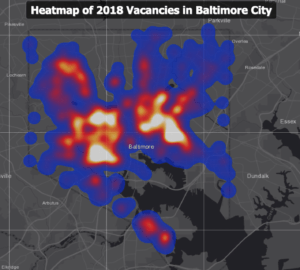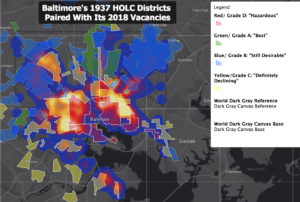Since both of my projects this summer are centered around mapping, this assignment was pretty easy to complete.
On the HFA side, here are two of my maps showing the different themes of active/future campaigns within the different HFA member groups based on city and the number of tenant unions being supported by each groups. One obvious boundary within these representations is that while this aims to illustrate the land and housing movement, it can only depict a small subset of a much larger movement (since not every organization concerned with this work is an HFA member).
- Themes of Active/Future campaigns being run by HFA member groups based on their city/information collected in HFA member census. Coral is Building-Based Justice, teal is Community Control, yellow is Renters’ Rights, pink is Development Without Displacement, Orange is Discrimination in Housing, green is Just Cause Eviction, blue is Rent Control, tangerine is Right to Counsel, and purple is Tenant Unions. Important to note that approximately 40 groups out of HFA’s 100+ member group network filled out the member census.
- Heatmap illustrating the number of tenant unions being supported by HFA member groups as reported in the HFA member census. As with the previous map, this dataset only reflects a subset of the entire HFA network.
While I’ve spent more of my time working with the HFA data, I’d certainly agree that my Baltimore maps are far more visually compelling and informative than those created from the member census. City government officials have long defended prioritizing the development of large-scale commercial projects for their potential to breathe life back into Baltimore’s economy, but this particular map calls into question whether this energy might be better spent elsewhere.

A heatmap of vacant buildings in Baltimore with 2018 eviction notices
The heatmap portion pulls from a live dataset of the city’s vacant buildings provided by the Housing Authority of Baltimore City via Open Baltimore, populated by nearly 2,000 buildings with 2018 eviction notice dates. As predicted, I found that a majority of the vacancies were clustered in East and West Baltimore, home to the city’s poorest neighborhoods.
This deterioration is by design, with roots stretching back to redlining policies instituted over a century ago (ever ahead of the curve, Baltimore became the first city to practice racial zoning in 1910) that segregated black residents into lower grade, “undesirable” neighborhoods.

Polygons representing the HOLC’s 1937 Baltimore Housing Security (redlining) map placed over the 2018 vacancy heatmap
Due to continued disinvestment, these zones continue to predict various economic, academic, and health outcomes decades later, with neighborhoods once placed in the lower grades experiencing lower rates of homeownership and college participation and higher poverty and mortality rates. In another version of my map, which layers the redlining zones from the 1937 Home Owners’ Loan Corporation map, one can see that the places with the most vacancies line up perfectly with the red and yellow (higher risk) zones.
While half of this particular map tells the story of where the city’s investment is most needed, the other half, which displays the past 3 years’ worth of commercial, residential, and mixed use development projects (via the Econview Project Data), shows where it’s actually been going. Aside from the fact that a majority of these points are collected around the Inner Harbor rather than the surrounding former redlined neighborhoods, very few of these projects have been dedicated towards housing, let alone affordable units that could help address the trends in East/West Baltimore.
- Different types of development proposals accepted by the city government between 2015 and 2018. Light blue is residential, dark blue is mixed-use, purple is retail, pink is hotel, magenta is industrial, and orange is office.
- Narrowing the scope of the previous dataset, this map pinpoints projects solely dedicated to housing and their varying levels of completion. Red stands for completed projects, purple are the planed projects, and blue are the ones currently under construction
- This final map shows the very small subset of the larger dataset of completed housing projects between 2015 and 2018 which included “affordable” in the project description.
On both ends of my work, that human element has still yet to be fully realized. I have the data, but I don’t have the voices which gives life to this issue. A dot on a map can’t illustrate the work groups have put into supporting their tenant unions, or the circumstances that motivated people to organize for development without displacement. A heatmap can’t give voice to the pain felt by those who have been evicted from the only homes they’ve ever known, just like brightly-colored shapes fail to encapsulate how decades of disinvestment have left those living within these red and yellow boundaries at a severe disadvantage and how they’re rebuilding without the help of those elected to supposedly bring about this change. The current iterations of my maps flatten experiences which are inherently complex.
That being said, I am taking steps to make these maps more representative of the populations they illustrate. On the HFA side, I will be able to more easily reach this goal once 1) the Renter Power assembly’s documentation team finishes typing up all of the notes written by each group on the physical map, 2) we’re able to set up our crowdsourced campaign map with different types of audio/visual media, and 3) (a more long-term goal similar to the Anti-Eviction Mapping Project’s “Narratives of Displacement” oral history map) once we conduct brief interviews with organizers in HFA’s member groups and other relevant parties. On the other end of my research, I’m looking to collect all of my research on Baltimore into an ArcGIS Story Map that is better equipped to help others make sense of the hard data, the historical context, and modern efforts to resist as a cohesive unit. As part of this, I’m looking to interview a member of the Baltimore Housing Roundtable that I met at the HFA assembly to speak towards the opportunities for community-based development that they’ve set in motion over the past few years (especially important since much of the data I’ve collected measures the city government’s negligence rather than efforts to rebuild), but I’d also love to speak with more people within East and West Baltimore who have long felt the legacy of redlining and are working to reverse their effects.






Love this post, especially the details about Baltimore and the use of historical maps to tell the story of redevelopment there. I wonder if the HOLC maps would tell us anything about some of the cities in the HFA group. That is, how is the story of poverty vs. redevelopment today really a story of how a 1930s policy has shaped the urban U.S. indefinitely? Of course, I’m also interested in what preceded the redlining maps. How did areas that were redlined become places that met that redlining criteria — how did the concentrations of mixed populations and aging infrastructure that redlining identified come to be? I have some ideas! On the topic of the maps themselves, I had a little bit of trouble reading your data through the heatmap. Let’s talk more about which visual tools might be better when I see you next. Great job!